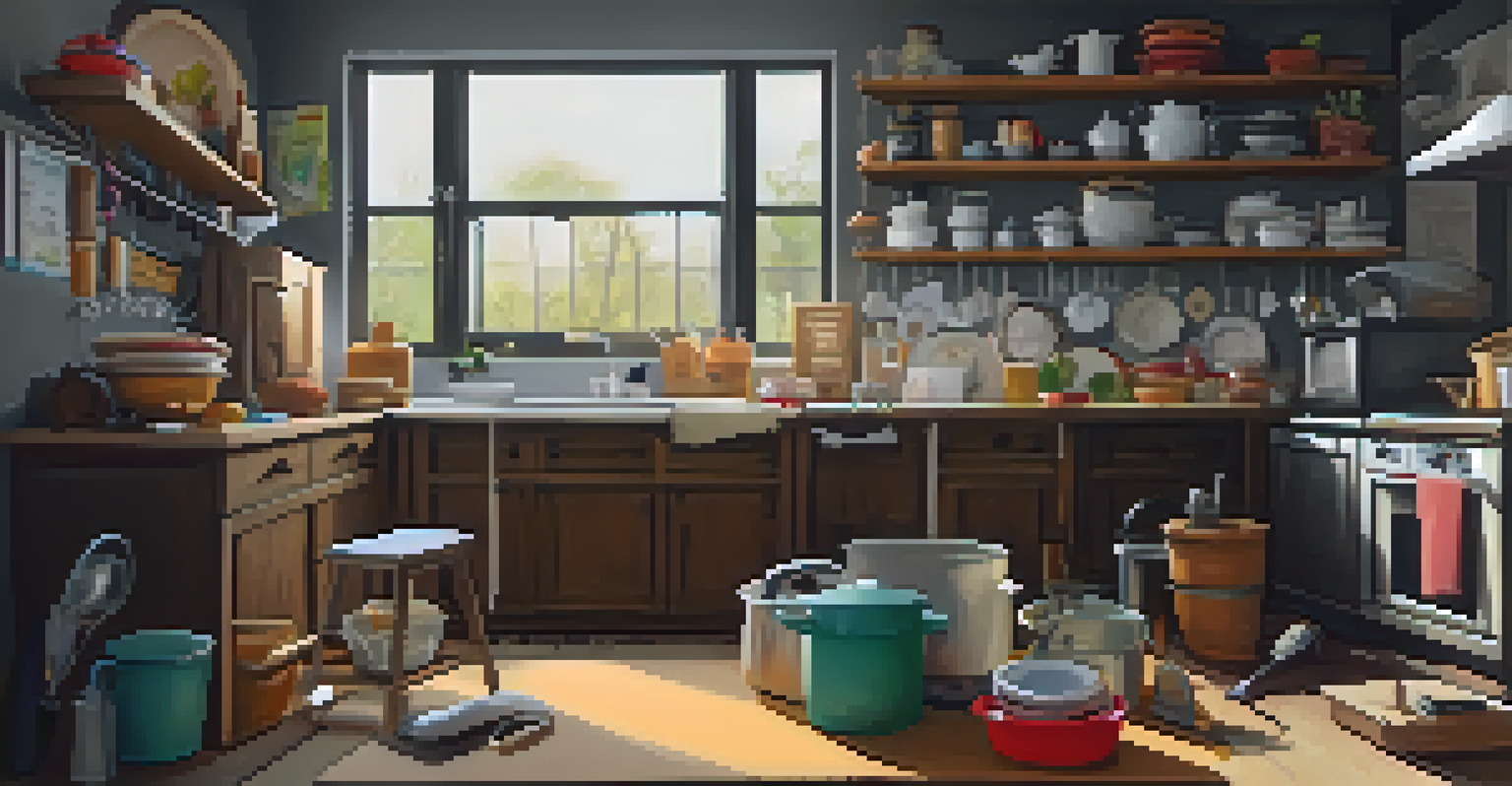Declutter Your Kitchen: 7 Tips for a Tidy Space

Start with a Clean Slate: Empty Your Kitchen
The first step to decluttering your kitchen is to empty it out completely. Start by taking everything out of your cabinets, drawers, and countertops. This might seem daunting, but think of it as a fresh start; it allows you to see exactly what you have.
The key to a clean and organized home is to let go of the things that no longer serve you.
As you clear the space, take this opportunity to clean those surfaces and get rid of any crumbs or dust that have accumulated over time. A clean kitchen is more inviting and makes the decluttering process much easier.
Once everything is out, you can begin to categorize your items, which will set the stage for making informed decisions about what to keep, toss, or donate.
Evaluate Your Kitchen Items: Keep, Toss, or Donate
Now that your kitchen is empty, it’s time to evaluate each item. Ask yourself questions like, 'Have I used this in the last year?' or 'Does this item bring me joy?' This helps you determine what to keep and what can go.

Be honest with yourself; if you have duplicates or items that serve the same purpose, it might be time to let some of them go. Remember, decluttering isn’t just about removing items; it’s about creating a space that works for you.
Start Fresh: Empty Your Kitchen
Clearing out your kitchen completely sets the stage for effective decluttering and organization.
Consider donating items in good condition to local charities or friends. Sharing your kitchen tools can help others while also freeing up valuable space in your home.
Organize by Category: Group Similar Items Together
Once you've decided what to keep, it’s helpful to organize your kitchen by category. Group together similar items, such as pots and pans, baking supplies, and utensils. This not only makes your kitchen look tidier but also makes finding things easier.
Clutter is nothing more than postponed decisions.
For example, keeping all your baking supplies in one spot allows you to quickly grab what you need when you’re ready to whip up a cake. Imagine how much time you’ll save when everything has a designated space.
Consider using labeling systems to make it even easier to find items. Labels can help everyone in the household know where things belong, keeping your kitchen organized for longer.
Use Storage Solutions: Maximize Your Space
To make the most of your kitchen space, consider investing in storage solutions. This can include shelves, drawer organizers, or even stackable containers for your pantry items. Think of these tools as the superheroes of your kitchen—they save the day by efficiently utilizing every nook and cranny.
Vertical space is often underutilized, so consider adding hooks for pots and pans or using magnetic strips for knives. These small changes can free up counter space and make your kitchen feel much larger.
Organize by Category for Efficiency
Grouping similar items together simplifies access and keeps your kitchen tidy.
Don’t forget about the inside of your cabinets; shelf risers can help you see everything at a glance, which minimizes clutter and maximizes functionality.
Create a Daily Cleaning Routine: Keep Clutter at Bay
To maintain your newly decluttered kitchen, it’s essential to create a daily cleaning routine. Set aside just a few minutes each day to wipe down surfaces, wash dishes, and put things back in their designated spots. Think of it as a quick check-up for your kitchen.
Incorporating this routine prevents clutter from building up again and helps you feel more in control of your space. After a meal, enlist everyone to pitch in; teamwork makes the task quicker and even a bit fun.
Remember, consistency is key. A few minutes each day can lead to a tidy kitchen that you’ll love spending time in.
Designate a ‘Clutter Zone’: Manage Marital Conflicts
Sometimes, you may find that not everyone has the same view on what clutter is, especially in shared spaces. Establishing a 'clutter zone' can help manage these conflicts. This is a specific area where items can be placed temporarily until a decision is made about them.
This approach allows you to keep the main kitchen space tidy while providing a designated area for items that might need further evaluation. Think of it as a waiting room for kitchen clutter.
Maintain Order with Daily Routines
Establishing a daily cleaning routine helps prevent clutter from accumulating again.
Just be sure to revisit this area regularly to prevent it from becoming a permanent fixture in your kitchen!
Celebrate Your Success: Enjoy Your Tidy Kitchen
After dedicating your time and energy to decluttering, take a moment to celebrate your success! A tidy kitchen is not just about aesthetics; it creates a more enjoyable space for cooking and gathering with family and friends.
Consider hosting a small dinner or baking session to show off your newly organized kitchen. It's a great way to appreciate the effort you've put in and share your space with loved ones.

Remember, maintaining a tidy kitchen is an ongoing process. Embrace the journey and enjoy the benefits of a clutter-free cooking environment.